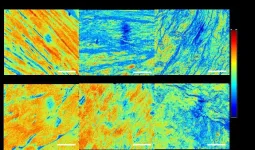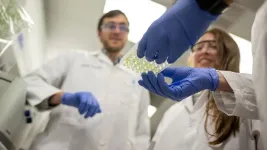(Press-News.org) Interactions with friends and family may keep us healthy because they boost our immune system and reduce our risk of diseases such as heart disease, stroke and type 2 diabetes, new research suggests.
Researchers from the UK and China drew this conclusion after studying proteins from blood samples taken from over 42,000 adults recruited to the UK Biobank. Their findings are published today in the journal Nature Human Behaviour.
Social relationships play an important role in our wellbeing. Evidence increasingly demonstrates that both social isolation and loneliness are linked to poorer health and an early death. Despite this evidence, however, the underlying mechanisms through which social relationships impact health remain elusive.
One way to explore biological mechanisms is to look at proteins circulating in the blood. Proteins are molecules produced by our genes and are essential for helping our bodies function properly. They can also serve as useful drug targets, allowing researchers to develop new treatments to tackle diseases.
A team led by scientists at the University of Cambridge, UK, and Fudan University, China, examined the ‘proteomes’ – the suite of proteins – in blood samples donated by over 42,000 adults aged 40-69 years who are taking part in the UK Biobank. This allowed them to see which proteins were present in higher levels among people who were socially isolated or lonely, and how these proteins were connected to poorer health.
The team calculated social isolation and loneliness scores for individuals. Social isolation is an objective measure based on, for example, whether someone lives alone, how frequently they have contact with others socially, and whether they take part in social activities. Loneliness, on the other hand, is a subjective measure based on whether an individual feels lonely.
When they analysed the proteomes and adjusted for factors such as age, sex and socioeconomic background, the team found 175 proteins associated with social isolation and 26 proteins associated with loneliness (though there was substantial overlap, with approximately 85% of the proteins associated with loneliness being shared with social isolation). Many of these proteins are produced in response to inflammation, viral infection and as part of our immune responses, as well as having been linked to cardiovascular disease, type 2 diabetes, stroke, and early death.
The team then used a statistical technique known as Mendelian randomization to explore the causal relationship between social isolation and loneliness on the one hand, and proteins on the other. Using this approach, they identified five proteins whose abundance was caused by loneliness.
Dr Chun Shen from the Department of Clinical Neurosciences at the University of Cambridge and the Institute of Science and Technology for Brain-Inspired Intelligence, Fudan University, said: “We know that social isolation and loneliness are linked to poorer health, but we’ve never understood why. Our work has highlighted a number of proteins that appear to play a key role in this relationship, with levels of some proteins in particular increasing as a direct consequence of loneliness.
Professor Jianfeng Feng from the University of Warwick said: "There are more than 100,000 proteins and many of their variants in the human body. AI and high throughput proteomics can help us pinpoint some key proteins in prevention, diagnosis, treatment and prognosis in many human diseases and revolutionise the traditional view of human health.
"The proteins we’ve identified give us clues to the biology underpinning poor health among people who are socially isolated or lonely, highlighting why social relationships play such an important part in keeping us healthy.”
One of the proteins produced in higher levels as a result of loneliness was ADM. Previous studies have shown that this protein plays a role in responding to stress and in regulating stress hormones and social hormones such as oxytocin – the so-called ‘love hormone’ – which can reduce stress and improve mood.
The team found a strong association between ADM and the volume of the insula, a brain hub for interoception, our ability to sense what's happening inside our body – the greater the ADM levels, the smaller the volume of this region. Higher ADM levels were also linked to lower volume of the left caudate, a region involved in emotional, reward, and social processes. In addition, higher levels of ADM were linked to increased risk of early death.
Another of the proteins, ASGR1, is associated with higher cholesterol and an increased risk of cardiovascular disease, while other identified proteins play roles in the development of insulin resistance, atherosclerosis (‘furring’ of the arteries) and cancer progression, for example.
Professor Barbara Sahakian from the Department of Psychiatry at the University of Cambridge said: “These findings drive home the importance of social contact in keeping us well. More and more people of all ages are reporting feeling lonely. That’s why the World Health Organization has described social isolation and loneliness as a ‘global public health concern’. We need to find ways to tackle this growing problem and keep people connected to help them stay healthy.”
The research was supported by the National Natural Sciences Foundation of China, China Postdoctoral Science Foundation, Shanghai Rising-Star Program, National Key R&D Program of China, Shanghai Municipal Science and Technology Major Project, 111 Project, Shanghai Center for Brain Science and Brain-Inspired Technology, and Zhangjiang Lab.
Reference
Shen, C et al. Plasma proteomic signatures of social isolation and loneliness associated with morbidity and mortality. Nat Hum Behav; 3 Jan 2025; DOI: 10.1038/s41562-024-02078-1
END
Loneliness linked to higher risk of heart disease and stroke and susceptibility to infection
2025-01-03
ELSE PRESS RELEASES FROM THIS DATE:
Some bacteria evolve like clockwork with the seasons
2025-01-03
Like Bill Murray in the movie “Groundhog Day,” bacteria species in a Wisconsin lake are in a kind of endless loop that they can’t seem to shake. Except in this case, it’s more like Groundhog Year.
According to a new study in Nature Microbiology, researchers found that through the course of a year, most individual species of bacteria in Lake Mendota rapidly evolved, apparently in response to dramatically changing seasons. Gene variants would rise and fall over generations, yet hundreds of separate species would return, almost fully, to near copies of what they had been genetically prior to a thousand or so generations of evolutionary pressures. (Individual microbes ...
New imaging technique offers insight into Achilles tendon injury recovery
2025-01-03
Achilles tendon injuries are common but challenging to monitor during recovery due to the limitations of current imaging techniques. Researchers, led by Associate Professor Zeng Nan from the International Graduate School at Shenzhen, Tsinghua University, have applied Mueller matrix polarimetry, a non-invasive imaging method, to more accurately observe and evaluate the healing of Achilles tendon injuries. This technique offers unique insights by capturing the subtle changes in tendon tissue without needing labels or dyes, allowing for more natural tissue characterization.
The study used Mueller ...
Bereavement science researcher provides insights on parasocial grief
2025-01-03
MIAMI, FLORIDA (Jan. 2, 2025) – Many people are surprised by the intensity of their response when a well-known person dies, and their feelings of sadness may last longer than they expect. In fact, that sadness and grief can be intense, and preliminary research suggests that grief after the death of a public figure looks very similar to grief over our personal relationships and can have comparable levels of intensity.
Wendy Lichtenthal, Ph.D., a bereavement science researcher, is available to discuss “parasocial grief” – that which occurs when a celebrity, political ...
New research aims to improve bridge construction in Texas
2025-01-02
A groundbreaking method for bridge construction is set to enhance performance, reduce construction time, and cut costs for future bridges across Texas.
Dr. Kinsey Skillen, assistant professor in the Civil and Environmental Engineering Department at Texas A&M University, was named Principal Investigator (PI) of the Texas Department of Transportation (TxDOT) research project titled “Develop/Refine Design Provisions for Headed and Hooked Reinforcement.”
The 42-month project, which received nearly $1 million in funding, is a joint effort between the Texas Transportation Institute and the University of Texas at San Antonio (UTSA) exploring more efficient methods ...
These bacteria perform a trick that could keep plants healthy
2025-01-02
To stay healthy, plants balance the energy they put into growing with the amount they use to defend against harmful bacteria. The mechanisms behind this equilibrium have largely remained mysterious.
Now, engineers at Princeton have found an answer in an unexpected place: the harmless, or sometimes beneficial, bacteria that cluster around plants’ roots.
In an article published Dec. 24 in the journal Cell Reports, researchers showed that some types of soil bacteria can influence a plant’s ...
Expanding the agenda for more just genomics
2025-01-02
Genomics is being integrated into biomedical research, medicine, and public health at a rapid pace, but the capacities necessary to ensure the fair, global distribution of benefits are lagging. A new special report outlines opportunities to enhance justice in genomics, toward a world in which genomic medicine promotes health equity, protects privacy, and respects the rights and values of individuals and communities.
The report, “Envisioning a More Just Genomics,” is a collaboration between ...
Detecting disease with only a single molecule
2025-01-02
UC Riverside scientists have developed a nanopore-based tool that could help diagnose illnesses much faster and with greater precision than current tests allow, by capturing signals from individual molecules.
Since the molecules scientists want to detect -- generally certain DNA or protein molecules -- are roughly one-billionth of a meter wide, the electrical signals they produce are very small and require specialized detection instruments.
“Right now, you need millions of molecules to detect ...
Robert McKeown recognized for a half century of distinguished service
2025-01-02
NEWPORT NEWS, VA – For nearly half a century, Robert D. “Bob” McKeown has probed nuclear particles and educated rising generations of physicists. Now, the former deputy director for science at the U.S. Department of Energy’s Thomas Jefferson National Accelerator Facility is being honored for his outstanding career contributions with the 2024 American Physical Society’s Division of Nuclear Physics (DNP) Distinguished Service Award.
McKeown is recognized for his work in experimental physics and his extensive leadership in the broader ...
University of Maryland awarded $7.8 million to revolutionize renewable energy for ocean monitoring devices
2025-01-02
University of Maryland researcher Stephanie Lansing received a Phase 1 $7.8M award from Defense Advanced Research Projects Agency (DARPA) to develop and test a biologically fueled energy source to power research and sensing devices throughout the world’s oceans.
There is a vast array of ocean sensing devices that provide critical information for understanding marine environments, monitoring climate change and maintaining national security. Many of these sensors are currently powered by long underwater cables or lithium-ion batteries.
Lansing is leading a large, collaborative effort that will overcome the need for batteries and ship-based or shore-based ...
Update: T cells may offer some protection in an H5N1 ‘spillover’ scenario
2025-01-02
Update: This LJI study was previously shared on bioRxiv in September 2024. Since then, health officials have reported a rise in H5N1 “bird flu” infections in humans, including the first severe H5N1 human case requiring hospitalization. Officials have also reported increased cases in feline species, including an outbreak among big cats at a wildlife sanctuary. In California, the recent spread of H5N1 to dairy herds in Southern California prompted Gov. Gavin Newsom to declare a “State of Emergency” on Dec. 18, 2024.
LA JOLLA, CA—New research led by scientists at La Jolla Institute for Immunology (LJI) ...





